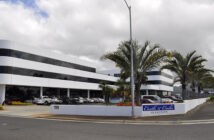 By John Cunningham and Dr Pascual Marques
By John Cunningham and Dr Pascual Marques
Unmanned ground (UGV), maritime (UMV) and aerial (UAV) vehicles offer increased capability in security missions, rescue operations, and the management of natural disasters. State border protection demands monitoring very large areas during an extended period of time. The US Customs and Border Protection (CBP) agency uses six Predator UAVs to patrol the southwestern and northern borders of the US. In Europe, the FRONTEX agency responsible for border security of Schengen member States supports the relentless monitoring of the northern coasts of the Mediterranean using unmanned aircraft in view of the current political climate in North Africa. Here is Part 1.
Instead of sending first responders directly to the potentially hazardous site of a disaster, unmanned vehicles can explore the area and collect valuable information without risking the lives of rescuers. Furthermore, vehicles equipped with sophisticated sensor systems detect hazards earlier and much more reliably than humans. By combining the capabilities of an experienced rescuer with those of a remotely operated vehicle, a powerful system is created that can deal with a large variety of security threats and dangers.
In the aftermath of severe natural disasters such as earthquakes, hurricanes, and tsunamis, soldiers and rescue teams are deployed to provide humanitarian assistance. Rescue teams benefit from rapid intelligence and analysis of the situation, which is best provided by robotic platforms that are versatile, have long endurance and provide live imagery essential for the movement of rescue teams and the safe transportation of vital equipment, food, drinking water and medical supplies.
In this article, we review the current capability of robotic UGVs, the need for integration of UMVs into current manned operations, and the critical role of UAVs to increase security and rescue efforts, and conduct effective surveillance of large geographical areas.
Adaptation of robotic UGVs to increase security and rescue efforts
There is an ever-increasing threat and need to improve security methods to prevent Improvised Explosive Devices (IEDs), suicide bombers, car bombs, and nuclear/biological/chemical devices being used against both military personnel and civilian targets. As the techniques being used to emplace IEDs are constantly evolving, there is emerging a growing need for a system capable of remotely removing rubble, which might be covering/concealing these devices, and clearing paths to reach these devices, which might otherwise be inaccessible. In addition, when severe natural disasters such as earthquakes, hurricanes, and tsunamis occur, soldiers and rescue teams are often called upon to provide humanitarian assistance. Thus, soldiers and rescue teams need a mobile robotic platform that is simple, versatile, and easy to transport. To support these needs, unmanned ground vehicle platforms must be quickly adapted to support a wide range of uses; specifically generator power, lights, powered tools, security sensors, camera systems, debris removal, and other.
Robotic systems assist security teams
Currently addressing this need, soldiers and civilian security teams are using on-site roadblocks, vehicle inspections, and inspecting rubble and debris piles for concealed IEDs. Unfortunately, with the ease that IEDs can be placed in a car, hidden adjacent to the road, or on insurgents themselves, these soldiers and security teams are easy targets, thus the potential is great to lose many personnel. With the increasing threat there is a need to put into place a robotic system to remove soldiers and rescue teams from this threat and provide a physical and visual deterrent to the insurgents that also allows the insurgents to be easily and safely captured. Adapting a robotic multi-task ground vehicle that remotely uncovers potential explosive hazards will allow the application of other systems and techniques to perform neutralisation of such improvised weapon systems. In addition, such robotic vehicles will be able to clear small rubble/debris from a route after determining whether it contains an explosive hazard, to avoid impeding the movement of ground forces or leaving a location suitable for concealing an explosive hazard. Such designs can be controlled with a series of manual, robotic, or autonomous control systems. READ MORE





